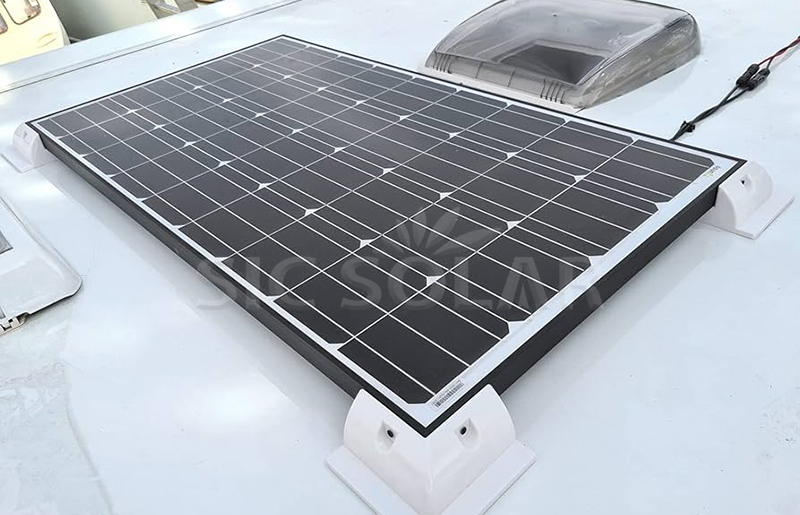For RV enthusiasts seeking energy independence, solar power offers a sustainable and cost-effective solution. Whether you’re camping off-grid or reducing reliance on noisy generators, understanding how an RV solar system works is key to maximizing its benefits. In this guide, we’ll break down the components, workflow, and best practices—while highlighting how SIC Solar innovative mounting systems enhance durability and efficiency.

1. Core Components of an RV Solar System
An RV solar system converts sunlight into usable electricity through four essential components:
Solar Panels:
Photovoltaic (PV) panels capture sunlight and convert it into direct current (DC) electricity. Monocrystalline panels are popular for their high efficiency (15–22%) and compact design, ideal for limited roof space.
Flexible thin-film panels are a lightweight alternative for curved surfaces but trade efficiency for versatility.
Charge Controller:
This device regulates the flow of electricity from panels to batteries, preventing overcharging. Maximum Power Point Tracking (MPPT) controllers optimize energy harvest, especially in variable weather, outperforming basic PWM models.
Battery Bank:
Batteries store excess energy for use at night or on cloudy days. Common options include:
Lithium-ion: High energy density, longer lifespan (3,000–5,000 cycles), and deep discharge capability.
AGM (Absorbent Glass Mat): Maintenance-free and spill-proof, suitable for budget-conscious users.
Inverter:
Converts DC power from batteries into alternating current (AC) to run household appliances like microwaves, laptops, and TVs. Pure sine wave inverters are recommended for sensitive electronics.
2. How the System Works: Step-by-Step Workflow
Energy Harvesting:
Solar panels generate DC electricity as sunlight strikes their photovoltaic cells. The angle and positioning of panels significantly impact efficiency. For example, a 30° tilt maximizes exposure in mid-latitudes.
Regulation and Storage:
The charge controller directs electricity to the battery bank while ensuring optimal voltage levels. MPPT controllers adjust input to match the battery’s state of charge, improving efficiency by up to 30% compared to PWM.
Power Conversion:
Stored DC energy passes through the inverter to become AC power, enabling compatibility with standard RV appliances.
Energy Consumption:
Appliances draw power from the inverter or directly from DC batteries (for low-voltage devices like LED lights).
3. Installation and Mounting: The Role of SIC Solar
A secure and efficient installation hinges on robust mounting systems. SIC Solar specializes in RV-friendly solutions designed to withstand harsh travel conditions:
Low-Profile Aluminum Rails:
These corrosion-resistant rails anchor panels firmly to the RV roof, minimizing wind resistance and vibrations. Their modular design accommodates both rigid and flexible panels.
Adjustable Tilt Brackets:
For RVs parked seasonally, tilt brackets optimize panel angles (15°–45°) to capture more sunlight. SIC Solar brackets integrate seamlessly with most rail systems, boosting energy yield by 10–20%.
Non-Penetrating Mounts:
Ideal for roofs with limited drilling options, these mounts use adhesive pads or weighted bases to secure panels without compromising structural integrity.
4. Maintenance and Optimization Tips
Regular Cleaning: Dust, pollen, and debris can reduce panel efficiency by 15–25%. Clean panels with a soft brush and mild detergent every 2–3 months.
Battery Health Checks: Monitor voltage levels and avoid deep discharges (below 20% for lead-acid batteries). Lithium batteries require less maintenance but benefit from temperature regulation.
Shading Management: Even partial shading can slash output. Use SIC Solar shading analysis tools during installation to avoid obstructions like vents or antennas.
5. Why Choose SIC Solar for Your RV Setup?
SIC Solar engineering expertise ensures your system performs reliably for years:
Durability: Anodized aluminum and ZAM-coated steel components resist rust and UV damage, even in coastal or high-humidity environments.
Modularity: Expand your system effortlessly with pre-drilled rails and universal clamps, ideal for adding panels later.
Warranty Assurance: A 25-year warranty on mounting systems aligns with solar panel lifespans, providing long-term peace of mind.